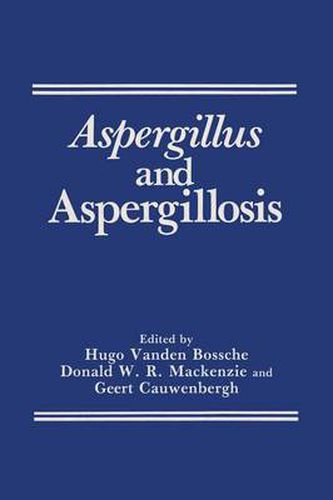Readings Newsletter
Become a Readings Member to make your shopping experience even easier.
Sign in or sign up for free!
You’re not far away from qualifying for FREE standard shipping within Australia
You’ve qualified for FREE standard shipping within Australia
The cart is loading…






This title is printed to order. This book may have been self-published. If so, we cannot guarantee the quality of the content. In the main most books will have gone through the editing process however some may not. We therefore suggest that you be aware of this before ordering this book. If in doubt check either the author or publisher’s details as we are unable to accept any returns unless they are faulty. Please contact us if you have any questions.
Species of aspergilli are common in man’s environment and are responsible for a wide spectrum of human and animal disease, ranging in animals from mycotic abortion to aflatoxicosis and in humans from localized colonization of the ear or skin to life-threatening systemic infection of neutropenic patients. In recent times, invasive aspergillosis has become increasingly important as a cause of morbidity and death, initially in patients receiving immunosuppression prior to organ transplantation, and latterly in haematologic patients rendered neutropenic by underlying disease or chemotherapy. In some centres, the condition has been recorded in more than 40% of patients dying with acute leukaemia. Laboratory diagnostic procedures are not always helpful and the diagnosis depends largely on clinical parameters. The clinician is faced with yet another problem, that of management. At present, antifungal therapy of invasive aspergillosis can be largely ineffectual, and the mortality rate remains unacceptably high. Since Aspergillus fumigatus was first described almost 125 years ago, several other pathogenic species have been recognized. The marked biosynthetic abilities and varied mechanisms of gene recombination of aspergilli have long commanded attention in food technology and genetics. Their equally varied abilities to cause disease have attracted the interest of toxicologists, allergists and physicians concerned with infectious diseases.
$9.00 standard shipping within Australia
FREE standard shipping within Australia for orders over $100.00
Express & International shipping calculated at checkout
This title is printed to order. This book may have been self-published. If so, we cannot guarantee the quality of the content. In the main most books will have gone through the editing process however some may not. We therefore suggest that you be aware of this before ordering this book. If in doubt check either the author or publisher’s details as we are unable to accept any returns unless they are faulty. Please contact us if you have any questions.
Species of aspergilli are common in man’s environment and are responsible for a wide spectrum of human and animal disease, ranging in animals from mycotic abortion to aflatoxicosis and in humans from localized colonization of the ear or skin to life-threatening systemic infection of neutropenic patients. In recent times, invasive aspergillosis has become increasingly important as a cause of morbidity and death, initially in patients receiving immunosuppression prior to organ transplantation, and latterly in haematologic patients rendered neutropenic by underlying disease or chemotherapy. In some centres, the condition has been recorded in more than 40% of patients dying with acute leukaemia. Laboratory diagnostic procedures are not always helpful and the diagnosis depends largely on clinical parameters. The clinician is faced with yet another problem, that of management. At present, antifungal therapy of invasive aspergillosis can be largely ineffectual, and the mortality rate remains unacceptably high. Since Aspergillus fumigatus was first described almost 125 years ago, several other pathogenic species have been recognized. The marked biosynthetic abilities and varied mechanisms of gene recombination of aspergilli have long commanded attention in food technology and genetics. Their equally varied abilities to cause disease have attracted the interest of toxicologists, allergists and physicians concerned with infectious diseases.